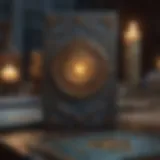Understanding Yes or No Tarot Readings Online
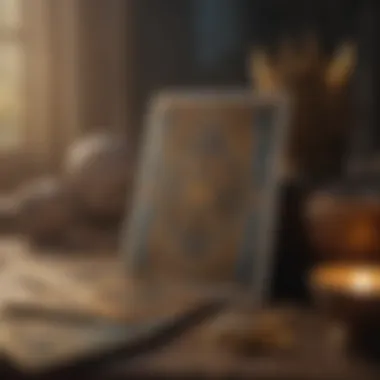

Intro
Yes or no tarot readings occupy a unique position in divination practices. They offer a straightforward method for individuals seeking clarity on specific questions. Unlike traditional tarot readings, which explore multiple aspects of a situation or person, yes or no readings cut straight to the point. This simplicity is appealing, especially in today's fast-paced digital world.
The rise of online tarot services has made this divinatory tool even more accessible. Users can connect with professional tarot readers from the comfort of their own homes. This shift has facilitated the growth of a community dedicated to these binary responses. Many users experience varying degrees of skepticism and belief, leading to broader discussions about the implications and applications of tarot as a guidance system.
This article will delve into the nuances of yes or no tarot readings. It will explore their significance, advantages, and the frameworks within which they operate. Through this, we aim to provide a comprehensive guide designed for both novices and seasoned practitioners.
Let's start with a closer look at the characteristics of the zodiac signs. Understanding these traits can lead to better interpretations of readings, allowing users to connect their queries with broader astrological considerations.
Understanding Tarot and Its Purpose
The exploration of tarot provides a framework for individuals seeking insight into their lives. Understanding Tarot and Its Purpose is essential for anyone interested in effective readings. Tarot has historical significance and practical applications that enhance its relevance today. It serves not just as a divinatory tool but as a means for personal reflection and understanding.
Definition of Tarot
Tarot consists of a deck of cards, traditionally 78 in total, used for divination or insight into one's life. It is a system that communicates complex ideas through symbols, images, and archetypes. Divided into two main sections, the Major Arcana and Minor Arcana, each card holds meaning and significance. The Major Arcana represents significant life events, while the Minor Arcana reflects everyday influences. Understanding these definitions forms the foundation for engaging with tarot effectively.
Historical Context
The origins of tarot date back to the 15th century in Europe, primarily as a card game. Over time, its use evolved into a mystical and esoteric practice. The transition from a game to a divinatory tool reflects societal changes and the rise of interest in spirituality and the occult. Various cultures contributed to tarot's development, incorporating their beliefs and interpretations. This historical context enriches the current practice and underscores the depth of what tarot represents.
Types of Tarot Decks
Numerous tarot decks exist, each designed with distinct imagery and interpretations. Common types include:
- Rider-Waite Tarot: Known for its straightforward symbolism and popularity, making it accessible for beginners.
- Thoth Tarot: Developed by Aleister Crowley, it embodies complex esoteric principles, appealing to advanced readers.
- Lenormand Cards: Though not traditional tarot, they offer a unique approach to divination with simpler, more direct interpretations.
- Oracle Cards: Different from tarot, these cards provide guidance based on personal insights rather than a standard 78-card structure.
Each deck aligns with different reader styles, influencing their approach to readings. Familiarity with these types helps in selecting the right deck for one's needs and enhances the reading experience.
The Concept of Yes or No Tarot Readings
Yes or no tarot readings hold a unique place in the broader landscape of tarot practices. Their straightforward nature appeals to both novices and seasoned practitioners, allowing for quick decisions and clarity in ambiguous situations. This article will shed light on the significance of yes or no readings, detailing their characteristics, ideal scenarios for application, along with their advantages and limitations.
Characteristics of Yes or No Readings
Yes or no tarot readings fundamentally differ from more comprehensive spreads. They focus on binary questions which require a clear affirmation or negation. The simplicity of this approach encourages individuals to confront their inquiries with directness.
- Brevity: Participants are often urged to formulate questions that can be answered simply. This contrasts with longer, multi-faceted inquiries which can complicate the reading.
- Clarity: The yes or no format promotes a conversational dynamic between the querent and the reader. It encourages a clearer understanding of the situation, as the answers can encompass complex emotions and thoughts while remaining succinct.
- Symbolism: Various tarot cards symbolize affirmative or negative responses. For instance, The Sun card often represents a positive outcome, while The Tower may indicate disruption or negative circumstances.
This structured approach reduces ambiguity, making it easier for readers to interpret the cards and convey their meanings to the querent.
Common Scenarios for Use
There are numerous situations in which yes or no tarot readings find their best applications. Many individuals arrive at these readings during pivotal moments in their lives, seeking guidance in decision-making.
- Relationship Decisions: Questions about partnerships, such as "Is this relationship right for me?" often arise. Such inquiries benefit from the yes or no format, allowing individuals to quickly assess compatibility.
- Career Moves: When contemplating a job offer or a change in careers, people may ask, "Should I accept this job?"
- Personal Growth: Individuals often seek clarity in self-improvement endeavors. Queries like, "Should I pursue this course?" crop up regularly.
Each scenario emphasizes the need for direct answers, eliminating the noise that comes from over-analysis. The straightforward approach allows querents to make decisions aligned with their instincts.
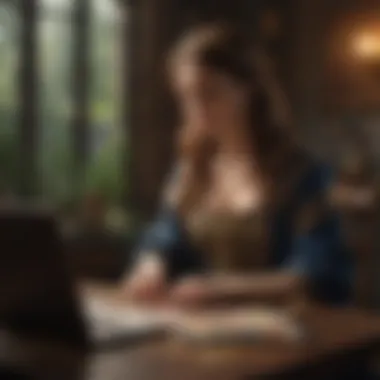

Advantages and Limitations
Yes or no tarot readings have distinct advantages that draw many seekers toward this method, but they are not without constraints.
- Advantages:
- Limitations:
- Simplicity: They offer immediate responses, making them suitable for those who might find comprehensive readings overwhelming.
- Accessibility: This format is approachable, capturing the interest of those new to tarot.
- Encouragement for Action: The format can prompt individuals to take decisive action based on the guidance received.
- Lack of Depth: These readings may lack the nuances found in traditional spreads. They don't provide in-depth analysis or broader context.
- Risk of Oversimplification: The nature of yes or no questions may lead to ignoring important facets of the situation.
"Tarot is a tool for introspection, and yes or no readings can steer one towards clarity, yet they come with the risk of oversimplifying complex personal issues."
In sum, yes or no tarot readings serve an important role in the tarot practice. Their clear, straightforward nature allows for quick guidance when faced with decisions, although users must remain conscious of the simplicity that might overlook deeper implications.
The Process of Online Yes or No Tarot Reading
The process of online Yes or No tarot reading offers a distinct approach to gaining guidance and clarity, particularly when navigating straightforward queries. This structure allows users to engage with tarot in a direct and efficient manner, contrasting with more elaborate types of tarot readings that may involve numerous cards and complex interpretations. In online settings, this approach can be beneficial due to its accessibility, providing immediate insights while accommodating those with limited understanding of tarot.
Finding an Online Tarot Reader
Identifying a reliable online tarot reader is crucial for a productive Yes or No reading. The digital landscape provides a plethora of options, which can be daunting. Potential clients should actively seek readers who convey a sense of transparency and professionalism in their profiles. Online platforms like Reddit often feature user reviews and discussions about various readers, which can guide one's choice. Furthermore, considering a reader's background and experience in the mystical arts is wise. A strong resonance with their style and philosophy can lead to a more meaningful interaction.
Formulating Questions
The effectiveness of Yes or No readings hinges significantly on how questions are crafted. Ambiguity can lead to confusion, while clear and specific questions facilitate direct answers. Thus, formulating questions should be approached thoughtfully. A good practice may involve rephrasing the question from various angles. For instance, instead of asking, "Will I be happy?" one could frame it as, "Is my current path likely to lead to happiness?" This approach transforms vague inquiries into more focused ones, ultimately enhancing the clarity of the reading.
Interpreting Outcomes
Interpreting the results of a Yes or No tarot reading requires careful consideration of the cards displayed and their contextual meanings. Each card carries unique implications, and the response to the question may not always be as straightforward as a simple yes or no. Instead, practitioners should look for nuances that might indicate a more complex scenario. For example, a card denoting positive energy could suggest a yes, while a challenge card might lean toward a no but could also imply necessary changes. Clients should not only consider the answer but also reflect on how the insights can be integrated into their lives, thereby gaining greater clarity on their situations.
Remember: The power of tarot is not simply in the answer it provides, but in the contemplation it inspires.
Engaging in the process of online Yes or No tarot readings demands a balance of openness and critical thinking. With the right reader, well-structured questions, and a thoughtful approach to interpretation, users may find the process both enriching and enlightening.
Best Practices for Online Tarot Readings
When engaging in online tarot readings, especially for yes or no inquiries, the process can be both intricate and revealing. Understanding best practices is paramount to derive clear and meaningful insights. These practices help cultivate a productive environment for both the reader and the querent, ensuring that the interaction aligns with their intentions. Below are key strategies to optimize the experience.
Setting Intentions
Setting clear intentions is fundamental to any tarot reading. Before engaging in a reading, take a moment to reflect on what you truly seek. This might involve formulating specific questions or simply stating what you desire from the reading experience.
- Clarity: The clearer your intention, the more focused the reading will be.
- Energy Alignment: A well-defined intention aligns the energies at play during the reading.
- Manifestation Assistance: By stating your intention, you set a pathway for potential manifestations.
When posing a question, make sure it is direct. For example, rather than asking "Will I be successful in my career?", consider a more succinct version, like "Should I pursue a job change?" This improves the odds of receiving a straightforward answer.
Maintaining an Open Mind
An open mind is essential for effective online tarot readings. The nature of tarot encourages exploration beyond conventional wisdom; therefore, being receptive is key.
- Avoid Preconceived Notions: Entering the reading without rigid expectations allows for broader insights.
- Embrace Multiple Outcomes: Each card has multiple interpretations. Allow yourself to explore different perspectives presented during the reading.
- Stay Engaged: Engage actively and thoughtfully while receiving guidance. Note the feelings and thoughts that arise. This engagement can often lead to deeper understandings.
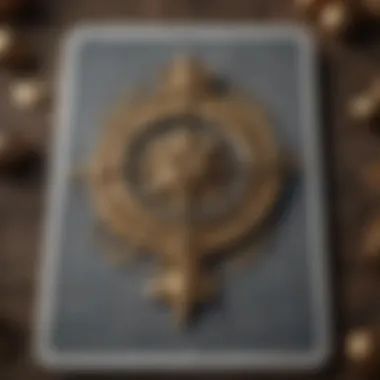

Reflecting on Readings
After the reading concludes, take time to reflect on the insights gained. This stage is as important as the reading itself to truly assimilate the messages.
- Journaling: Write down your thoughts and feelings about the reading. Include the questions asked, cards drawn, and emotional responses. This can aid in personal growth and reveal patterns over time.
- Discuss with Others: Sharing your insights with friends or fellow enthusiasts can provide alternative perspectives that deepen your understanding.
- Consider Changes: Reflect on how the reading aligns with your current circumstances and consider if any actions are needed.
In summary, the best practices for online tarot readings foster a more insightful and enriching interaction. Setting intentions, maintaining openness, and reflecting on the outcomes contribute to a holistic tarot experience. By incorporating these strategies, you can enhance the clarity and significance of your readings.
Yes or No Tarot Readings in the Context of Astrology
Yes or no tarot readings find a significant place within the broader framework of astrology. The interplay between tarot and astrology enriches the divinatory experience, offering deeper insights into personal circumstances. Many seek not only binary answers but also a clearer connection to cosmic influences. Understanding how astrological factors blend with tarot readings can enhance interpretation and allow for more informed decisions.
Astrological Influences on Tarot
Astrology serves as an essential backdrop for tarot readings. Each tarot card resonates with certain astrological elements. For example, the Major Arcana cards are linked to planetary influences and zodiac signs. When conducting a yes or no reading, consider the position of planets and their aspects. For example, a question asked under a Mercury retrograde period may yield different connotations compared to one asked during a harmonious Venus aspect.
Moreover, the Moon’s phases impact intuition and emotions. A reading conducted during a Full Moon might reveal clearer answers due to heightened emotional sensitivity. Recognizing these astrological rhythms provides context not just for the cards drawn but also for the timing of the questions posed.
Connecting Tarot to Zodiac Signs
Each zodiac sign embodies unique characteristics, and these can influence the interpretation of a tarot reading. For instance, Aries is known for being bold and decisive, while Taurus is patient and grounded. When one asks a yes or no question, knowing the zodiac sign associated with the querent can shape how the cards are understood.
Here are some notable connections between tarot and zodiac signs:
- Aries: Often resonates with The Emperor, symbolizing control and leadership.
- Taurus: Connected to The Hierophant, indicating tradition and stability.
- Gemini: Relates well to The Lovers, focused on choices and duality.
- Cancer: Linked with The Chariot, suggesting emotional strength and movement.
- Leo: Ties to Strength, showcasing courage and self-confidence.
- Virgo: Aligns with The Hermit, emphasizing introspection and wisdom.
- Libra: Associated with Justice, reflecting balance and fair decision-making.
- Scorpio: Related to Death, representing transformation and rebirth.
- Sagittarius: Corresponds with The Fool, embodying adventure and open-mindedness.
- Capricorn: Linked to The Devil, highlighting themes of ambition and restriction.
- Aquarius: Resonates with The Star, encouraging hope and inspiration.
- Pisces: Connects with The Moon, reflecting dreams, intuition, and the unconscious.
By recognizing these relationships, tarot practitioners can offer tailored insights during yes or no readings, enhancing the user’s understanding of how astrological energies might influence their inquiries. This integrated approach deepens the significance of the answers obtained and promotes a more holistic understanding of the influences at play.
Ethical Considerations in Tarot Readings
The ethical dimensions of tarot readings are crucial for practitioners and clients alike. Understanding these considerations ensures that both parties engage in a respectful and informed manner. Ethical practices in tarot readings foster trust and transparency. This also protects the clientele from potential harm.
Consent and Transparency
Consent is fundamental in any form of guidance, and tarot readings are no exception. A reader must obtain clear consent from the client before proceeding with any reading. This means the individual seeking insights should be fully informed about the nature of the session. Tarot readers must discuss their approach and answer any questions the client might have about how the reading will be conducted.
Moreover, transparency leads to more fruitful readings, as it allows the client to engage openly. For instance, outlining any potential limitations, such as the general nature of a yes or no reading, can prevent misunderstandings. If a question posed has multiple layers or requires nuance, it is the reader's duty to inform the client. Leaving clients in the dark can lead to misinterpretations of the messages received.
Potential for Misuse
The use of tarot for manipulation or deceit is a critical issue. Readers must acknowledge the potential for misuse of their gifts. There are individuals who may seek to exploit clients' vulnerabilities, especially in times of emotional distress. Such actions can result in emotional harm or misguided life choices that are not based on sound guidance.
To mitigate this risk, ethical readers should operate with integrity, ensuring that they only deliver readings that can genuinely help. This means refraining from making absolute predictions about the future or expressing opinions that could lead someone astray. Practitioners should focus on empowering clients to make their decisions rather than dictating them.
In essence, the responsibility lies with the reader to uphold ethical standards. This not only protects their practice but also preserves the sacred trust placed in them by the clients. As tarot continues to be embraced in various contexts, these ethical considerations will remain vital for maintaining the credibility and respect of the practice.
The Future of Tarot Readings in the Digital Age
The future of tarot readings in the digital landscape is a fascinating subject, revealing significant shifts in how individuals engage with this timeless practice. Online platforms have democratized access to tarot, allowing anyone with an internet connection to seek guidance. This accessibility can lead to greater exploration and understanding of tarot, fostering a wider appreciation of its potential. Understanding this future is vital because it shapes how practitioners and seekers alike navigate their spiritual journeys.
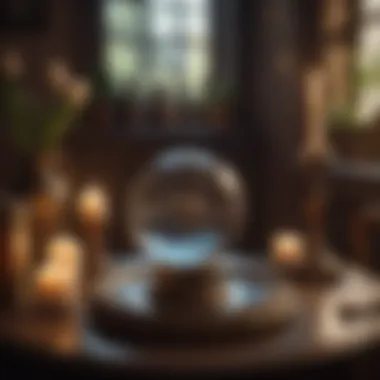

Emerging Technologies
Technology is rapidly changing the landscape of tarot readings. Mobile applications, artificial intelligence, and online communities are just a few examples of how the practice has evolved. These innovations have led to the creation of tarot apps that not only offer card readings but also incorporate personalized recommendations based on user input.
For instance, many apps use algorithms to provide tailored insights based on previous interactions, enhancing the user experience. Practitioners can also leverage social media platforms to connect with a larger audience, share their knowledge, and conduct live readings. This real-time interaction brings a new level of immediacy and connection that was previously unattainable.
Moreover, advancements in virtual reality could potentially allow for immersive tarot experiences, challenging traditional methods and engaging users in novel ways. However, it is essential to remain mindful of the profound nature of tarot; digital tools should be a supplement, not a substitute for intuition and personal connection.
The Role of Community in Online Readings
Community plays a crucial part in the future of tarot readings. The evolution of digital platforms has enabled the formation of online communities where enthusiasts can share insights and experiences. This fosters a collaborative environment, promoting learning and growth.
From Reddit forums to Facebook groups, individuals can now engage with diverse perspectives about tarot. They can discuss their experiences with yes or no readings or seek advice on how to interpret specific cards. Such spaces support an inclusive dialogue that can lead to deeper understanding.
Furthermore, community feedback can enhance the quality of readings and encourage ethical practices. Through shared experiences, users can learn about the nuances involved in interpreting tarot, while readers benefit from constructive criticism and insights from their audience. The amalgamation of technology and community creates a rich tapestry that challenges and supports tarot practitioners in the digital usage of this esoteric technique.
Personal Experiences with Online Yes or No Tarot
The significance of personal experiences with online yes or no tarot readings offers valuable insights into how individuals interact with tarot in the digital context. Each experience serves as a window into the diverse ways people seek answers and cope with uncertainty. By analyzing these encounters, we can glean information about the strengths and weaknesses of this method.
Online tarot platforms have made these readings widely accessible. Users can easily connect with readers from around the world. This accessibility allows for immediate feedback, which many find comforting. Instant answers resonate well with those who often face time constraints or stressful situations. However, the internet is also a place where overwhelming choices can lead to confusion. Without proper guidance, users might feel lost in the abundance of options.
Moreover, the anonymity offered by online readings encourages openness. People may feel more inclined to share their most pressing concerns when they can do so without direct exposure. This means that questions posed in these sessions can reflect deeper issues like personal relationships, career aspirations, or existential dilemmas. Understanding what drives individuals to seek these readings online adds to our appreciation of its role in personal clarity.
Ultimately, personal stories can highlight specific benefits of this tarot methodology, such as increased confidence in decision-making processes. They can also bring attention to important considerations like the need for ethical practices in online tarot. People's experiences underline the blend of hope and skepticism that surrounds tarot readings, often influencing their overall perception of the practice.
Case Studies and Anecdotes
Personal anecdotes serve as powerful testimonials about the effectiveness of yes or no tarot readings. For instance, one user, Sarah, shared her experience of consulting an online tarot reader amidst a career dilemma. Her question was simple: "Should I accept the job offer?" The reader drew three cards, each indicating a strong affirmation. Sarah stated that the clarity she gained from that quick session helped her make a decision she had been indecisive about for weeks.
Another individual, Mark, relayed a different sentiment. When he sought a yes or no answer about his relationship, he received a card that indicated caution. He reflected on the reading by emphasizing how it sparked introspection on his relationship patterns. Neither outcome was what he initially hoped for, but both case studies emphasize how the readings provided real value in guiding personal choices.
These examples illustrate that personal experiences are not monolithic. They range from affirming validation to challenging insights. The juxtaposition of positive and negative revelations indicates the complexity inherent in tarot readings, especially those conducted online.
Lessons Learned
Through diverse personal narratives, several lessons emerge concerning online yes or no tarot readings:
- Self-Reflection is Key: Individuals often discover more about themselves through the process of questioning. The act of formulating a question can lead to deeper understanding and character growth.
- Trust in the Process: While immediate answers are attractive, patience in interpretation is crucial. Readings are often more nuanced than a simple "yes" or "no". Users may need to consider the broader context of the readings.
- Seek Constructive Guidance: Choosing a reputable online tarot service is essential. Users should research to find readers whose styles and philosophies align with their needs.
- Caution with Emotional Responses: Emotional investment can skew the perception of readings. Users need to remain aware of their biases when interpreting outcomes.
Closure
The exploration of yes or no tarot readings online sheds light on a unique practice that combines ancient wisdom with modern convenience. Understanding the nuances of these readings becomes crucial, especially for those who seek direct answers to pressing questions in life. The binary nature of these readings can provide immediate insights, which can be particularly appealing for individuals who might not want to engage in extensive interpretations.
Final Thoughts on Yes or No Tarot Readings
Yes or no tarot readings serve as a tool for quick decision-making, offering clarity in a chaotic world. This straightforward approach can help individuals identify their paths and consider their options without the clutter of elaborate signification behind each card. While deeper interpretations exist, the directness of binary responses can be beneficial for quick assessments. By focusing on clarity and intention, people can glean significant insights from what may appear to be a simplified method.
Moreover, it’s essential to recognize that these readings are not absolute truths but rather guideposts that can facilitate personal reflection.
Encouragement for Further Exploration
The world of tarot is vast and multifaceted. Engaging in yes or no readings can be the entry point for many into the broader practice of tarot. Those interested in developing their skills can explore various tarot decks and study different reading methodologies. Learning about card meanings and the interplay of various elements within a reading can deepen understanding and enhance the overall experience.
In essence, whether one is a novice or seasoned practitioner, there is ample room for growth and exploration. For further insight, participating in forums or connecting with communities on platforms such as Reddit or Facebook can lead to shared experiences and wisdom. Tarot is not merely a tool; it is an evolving journey of self-discovery.
"Tarot connects us to our intuitive selves, whispering the possibilities of our choices."
Exploring yes or no tarot readings is just the beginning. Dive deeper into this rich landscape to unlock layers of meaning that can profoundly impact your life.
